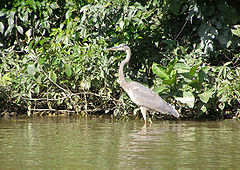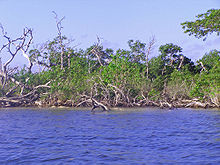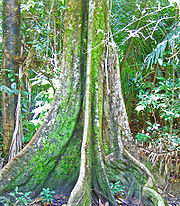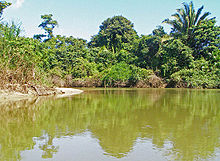
Monkey River
Encyclopedia

Coast
A coastline or seashore is the area where land meets the sea or ocean. A precise line that can be called a coastline cannot be determined due to the dynamic nature of tides. The term "coastal zone" can be used instead, which is a spatial zone where interaction of the sea and land processes occurs...
al watercourse
Watercourse
A watercourse is any flowing body of water. These include rivers, streams, anabranches, and so forth.-See also:* physical geography* Environmental flow* Waterway* Hydrology* Wadi-External links:...
in southern Belize
Belize
Belize is a constitutional monarchy and the northernmost country in Central America. Belize has a diverse society, comprising many cultures and languages. Even though Kriol and Spanish are spoken among the population, Belize is the only country in Central America where English is the official...
that rises in the Maya Mountains
Maya Mountains
The Maya Mountains are a mountain range in Belize and eastern Guatemala. The highest peaks are Doyle's Delight at and Victoria Peak at . The Maya Mountains and associated foothills contain a number of important Mayan ruins including the sites of Lubaantun, Nim Li Punit, Cahal Pech, and Chaa Creek;...
and discharges to the Caribbean Sea
Caribbean Sea
The Caribbean Sea is a sea of the Atlantic Ocean located in the tropics of the Western hemisphere. It is bounded by Mexico and Central America to the west and southwest, to the north by the Greater Antilles, and to the east by the Lesser Antilles....
near Monkey River Town
Monkey River Town
Monkey River Town is a village in the north of the Toledo District of the Central American nation of Belize. It is on the Caribbean Sea on the southern shore of the mouth of Belize's Monkey River...
. One of Belize's major rivers, Monkey River has northern headwaters which originate in the Cockscomb Basin Wildlife Sanctuary
Cockscomb Basin Wildlife Sanctuary
The Cockscomb Basin Wildlife Sanctuary is a nature reserve in south-central Belize established to protect the forests, fauna and watersheds of an approximately 400 square kilometre area of the eastern slopes of the Maya Mountains...
, where the Swasey Branch drains the East Basin of that wildlife
Wildlife
Wildlife includes all non-domesticated plants, animals and other organisms. Domesticating wild plant and animal species for human benefit has occurred many times all over the planet, and has a major impact on the environment, both positive and negative....
sanctuary. Further south, the Bladen Branch watercourse drains the eastern slopes of the Maya Mountains including the ancient Maya
Maya civilization
The Maya is a Mesoamerican civilization, noted for the only known fully developed written language of the pre-Columbian Americas, as well as for its art, architecture, and mathematical and astronomical systems. Initially established during the Pre-Classic period The Maya is a Mesoamerican...
n settlement areas of Lubaantun
Lubaantun
Lubaantun is a pre-Columbian ruined city of the Maya civilization in southern Belize, Central America...
and Nim Li Punit
Nim Li Punit
Nim Li Punit, is a Maya Classic Period site in the Toledo District of the nation of Belize, located 40 kilometres north of the town of Punta Gorda, at 16° 19' N, 88° 47' 60W...
. These two watercourses join to form the Monkey River approximately 16 kilometres upstream from the mouth of the Monkey River. The Monkey River is readily navigated throughout the year using small boats, but navigation above the major confluence (of Bladen and Swasey Branches) becomes more difficult due to lack of depth when the dry season starts about February. Habitats in this watershed provide cover for such diverse species as the ocelot
Ocelot
The ocelot , pronounced /ˈɒsəˌlɒt/, also known as the dwarf leopard or McKenney's wildcat is a wild cat distributed over South and Central America and Mexico, but has been reported as far north as Texas and in Trinidad, in the Caribbean...
, jaguar
Jaguar
The jaguar is a big cat, a feline in the Panthera genus, and is the only Panthera species found in the Americas. The jaguar is the third-largest feline after the tiger and the lion, and the largest in the Western Hemisphere. The jaguar's present range extends from Southern United States and Mexico...
, Guatemalan Black Howler
Guatemalan Black Howler
The Guatemalan black howler, or Yucatan black howler, is a species of howler monkey, a type of New World monkey, from Central America. It is found in Belize, Guatemala and Mexico, in and near the Yucatan Peninsula. It lives in evergreen, semi-deciduous and lowland rain forests...
, Bare-throated Tiger Heron
Bare-throated Tiger Heron
The Bare-throated Tiger Heron, Tigrisoma mexicanum, is a wading bird of the heron family Ardeidae, found from Mexico to northwestern Colombia, with one recorded sighting from the United States in Hidalgo County, Texas...
, Morelet's Crocodile
Morelet's Crocodile
Morelet's crocodile, also known as the Mexican crocodile, is a modest sized crocodilian found only in fresh waters of the Atlantic regions of Mexico, Belize and Guatemala. It usually grows to about in length. It is an endangered species.-History:...
, Fer-de-Lance
Fer-de-Lance
Fer-de-Lance is French for spearhead , and may refer to:Snakes:*Bothrops lanceolatus, the Martinique lancehead *B. caribbaeus, the Saint Lucia lancehead...
and manatee
Manatee
Manatees are large, fully aquatic, mostly herbivorous marine mammals sometimes known as sea cows...
.
Hydrology

Maya Mountains
The Maya Mountains are a mountain range in Belize and eastern Guatemala. The highest peaks are Doyle's Delight at and Victoria Peak at . The Maya Mountains and associated foothills contain a number of important Mayan ruins including the sites of Lubaantun, Nim Li Punit, Cahal Pech, and Chaa Creek;...
Marine Area Transect, which connects the Maya Mountains to the coastal waters of the Gulf of Honduras
Gulf of Honduras
The Gulf or Bay of Honduras is a large inlet of the Caribbean Sea, indenting the coasts of Belize, Guatemala, and Honduras. From north to south, it runs for approximately 200 km from Dangriga, Belize, to La Ceiba, Honduras....
. According to The Nature Conservancy
The Nature Conservancy
The Nature Conservancy is a US charitable environmental organization that works to preserve the plants, animals, and natural communities that represent the diversity of life on Earth by protecting the lands and waters they need to survive....
: "The Monkey River in southern Belize supports one of the most pristine coral reefs in Central America, which is part of the second largest barrier-reef
Coral reef
Coral reefs are underwater structures made from calcium carbonate secreted by corals. Coral reefs are colonies of tiny living animals found in marine waters that contain few nutrients. Most coral reefs are built from stony corals, which in turn consist of polyps that cluster in groups. The polyps...
system in the world." Thus the water quality
Water quality
Water quality is the physical, chemical and biological characteristics of water. It is a measure of the condition of water relative to the requirements of one or more biotic species and or to any human need or purpose. It is most frequently used by reference to a set of standards against which...
of the Monkey River supports not only freshwater
Freshwater
Fresh water is naturally occurring water on the Earth's surface in ice sheets, ice caps, glaciers, bogs, ponds, lakes, rivers and streams, and underground as groundwater in aquifers and underground streams. Fresh water is generally characterized by having low concentrations of dissolved salts and...
species
Species
In biology, a species is one of the basic units of biological classification and a taxonomic rank. A species is often defined as a group of organisms capable of interbreeding and producing fertile offspring. While in many cases this definition is adequate, more precise or differing measures are...
in the river's upper reaches and estuarine
Estuary
An estuary is a partly enclosed coastal body of water with one or more rivers or streams flowing into it, and with a free connection to the open sea....
species in the lower reaches, but also the sensitive offshore Belize Barrier Reef
Belize Barrier Reef
The Belize Barrier Reef is a series of coral reefs straddling the coast of Belize, roughly offshore in the north and in the south within the country limits...
.
The Monkey River drains much of southern Belize through the Bladen (southern) Branch, which includes tributaries from a part of southern Guatemala
Guatemala
Guatemala is a country in Central America bordered by Mexico to the north and west, the Pacific Ocean to the southwest, Belize to the northeast, the Caribbean to the east, and Honduras and El Salvador to the southeast...
and the southern slopes of the Maya Mountains in Belize, containing the ancient Mayan sites of Nim Li Punit
Nim Li Punit
Nim Li Punit, is a Maya Classic Period site in the Toledo District of the nation of Belize, located 40 kilometres north of the town of Punta Gorda, at 16° 19' N, 88° 47' 60W...
and Lubaantun
Lubaantun
Lubaantun is a pre-Columbian ruined city of the Maya civilization in southern Belize, Central America...
. The (northern) Swasey Branch of the Monkey River rises in the East Basin of the Cockscomb Basin Wildlife Sanctuary
Cockscomb Basin Wildlife Sanctuary
The Cockscomb Basin Wildlife Sanctuary is a nature reserve in south-central Belize established to protect the forests, fauna and watersheds of an approximately 400 square kilometre area of the eastern slopes of the Maya Mountains...
, a wilderness area set aside for jaguar preservation. During the rainy season, the Monkey River manifests considerable turbidity
Turbidity
Turbidity is the cloudiness or haziness of a fluid caused by individual particles that are generally invisible to the naked eye, similar to smoke in air. The measurement of turbidity is a key test of water quality....
.
Ecology

Coastal plain
A coastal plain is an area of flat, low-lying land adjacent to a seacoast and separated from the interior by other features. One of the world's longest coastal plains is located in eastern South America. The southwestern coastal plain of North America is notable for its species diversity...
broadleaf secondary forest
Secondary forest
A secondary forest is a forest or woodland area which has re-grown after a major disturbance such as fire, insect infestation, timber harvest or windthrow, until a long enough period has passed so that the effects of the disturbance are no longer evident...
; (c) upper river freshwater riverine habitat; (d) lower reach estuarine and mangrove
Mangrove
Mangroves are various kinds of trees up to medium height and shrubs that grow in saline coastal sediment habitats in the tropics and subtropics – mainly between latitudes N and S...
habitats; and (e) Caribbean Sea
Caribbean Sea
The Caribbean Sea is a sea of the Atlantic Ocean located in the tropics of the Western hemisphere. It is bounded by Mexico and Central America to the west and southwest, to the north by the Greater Antilles, and to the east by the Lesser Antilles....
coral reef and Turtle-grass
Seagrass
Seagrasses are flowering plants from one of four plant families , all in the order Alismatales , which grow in marine, fully saline environments.-Ecology:...
marine habitat. This shallow marine environment is home to the endangered
Endangered species
An endangered species is a population of organisms which is at risk of becoming extinct because it is either few in numbers, or threatened by changing environmental or predation parameters...
manatee. Each of these five discrete ecosystem
Ecosystem
An ecosystem is a biological environment consisting of all the organisms living in a particular area, as well as all the nonliving , physical components of the environment with which the organisms interact, such as air, soil, water and sunlight....
s contains important habitat for either terrestrial or aquatic species of southern Belize.
The highest upland watershed area contains expansive forests, which are primary in the highest elevations and secondary in the lower foothills
Foothills
Foothills are geographically defined as gradual increases in elevation at the base of a mountain range. They are a transition zone between plains and low relief hills to the adjacent topographically high mountains.-Examples:...
of the Maya Mountains. These montane areas provided an impenetrable protective backdrop for the ancient Mayan settlements here, preventing invasion from any tribes resident in Honduras
Honduras
Honduras is a republic in Central America. It was previously known as Spanish Honduras to differentiate it from British Honduras, which became the modern-day state of Belize...
or Guatemala. These forests have important lumber species such as mahogany
Mahogany
The name mahogany is used when referring to numerous varieties of dark-colored hardwood. It is a native American word originally used for the wood of the species Swietenia mahagoni, known as West Indian or Cuban mahogany....
and cedar
Cedar wood
Cedar wood comes from several different trees that grow in different parts of the world, and may have different uses.* California incense-cedar, from Calocedrus decurrens, is the primary type of wood used for making pencils...
trees and a broad panoply of other broadleaf tree species as well as numerous liana
Liana
A liana is any of various long-stemmed, woody vines that are rooted in the soil at ground level and use trees, as well as other means of vertical support, to climb up to the canopy to get access to well-lit areas of the forest. Lianas are especially characteristic of tropical moist deciduous...
s. Fauna include the jaguar, margay
Margay
The Margay is a spotted cat native to Middle and South America. Named for Prince Maximilian of Wied-Neuwied, it is a solitary and nocturnal animal that prefers remote sections of the rainforest. Although it was once believed to be vulnerable to extinction, the IUCN now lists it as "Near Threatened"...
, tapir
Tapir
A Tapir is a large browsing mammal, similar in shape to a pig, with a short, prehensile snout. Tapirs inhabit jungle and forest regions of South America, Central America, and Southeast Asia. There are four species of Tapirs: the Brazilian Tapir, the Malayan Tapir, Baird's Tapir and the Mountain...
and venom
Venom
Venom is the general term referring to any variety of toxins used by certain types of animals that inject it into their victims by the means of a bite or a sting...
ous pit viper Fer-de-lance, Bothrops asper
Bothrops asper
Bothrops asper is a venomous pit viper species ranging from southern Mexico to northern South America. Sometimes referred to as the "ultimate pit viper," these snakes are found in a wide range of lowland habitats, often near human habitations. This species is the main cause of snakebite incidents...
.
Along the middle and lower reaches, the forest is secondary, betraying the heritage of banana
Banana
Banana is the common name for herbaceous plants of the genus Musa and for the fruit they produce. Bananas come in a variety of sizes and colors when ripe, including yellow, purple, and red....
farms and slash-and-burn practises used historically in this area. Today much of this area is protected as the Payne's Creek National Park
Payne's Creek National Park
Payne's Creek National Park is a nature reserve in the Toledo District of southern Belize. This national park, stretched along the lower reaches of the Monkey River, was previously disturbed by banana farming and slash-and-burn agricultural practises; however, in 2007 a verdant broadleaf secondary...
. Here, relatively dense jungle
Jungle
A Jungle is an area of land in the tropics overgrown with dense vegetation.The word jungle originates from the Sanskrit word jangala which referred to uncultivated land. Although the Sanskrit word refers to "dry land", it has been suggested that an Anglo-Indian interpretation led to its...
canopy has returned, resulting in a closed canopy of approximately 15 to 20 metres in height. Yellow bay cedar and other significant sized broadleaf species abound, along with numerous tropical vines and thorny undergrowth flora. A machete
Machete
The machete is a large cleaver-like cutting tool. The blade is typically long and usually under thick. In the English language, an equivalent term is matchet, though it is less commonly known...
is essential for exploration even where there is an established trail. Black howler monkey troops are plentiful, each troop maintaining a home range of 40,000 to 70,000 square metres in this forest.
Ecotourism

Ecotourism
Ecotourism is a form of tourism visiting fragile, pristine, and usually protected areas, intended as a low impact and often small scale alternative to standard commercial tourism...
for southern Belize. Most trips originate from Placencia
Placencia
Placencia is a small town located in the Stann Creek District of Belize. It is the most southern town on the largest peninsula of the Gulf of Mexico.-History:...
or Roberts Grove, both marinas on the southern part of the Placencia Peninsula, located approximately 35 kilometres northeast of the mouth of the Monkey River. These small motorised boats typically stop at Monkey River Town
Monkey River Town
Monkey River Town is a village in the north of the Toledo District of the Central American nation of Belize. It is on the Caribbean Sea on the southern shore of the mouth of Belize's Monkey River...
for lunch and an exposure to the roadless native populace at that village. Most often the boat trips land at a location about ten kilometers upriver from the mouth to allow visitors a walk through the secondary growth
Secondary growth
In many vascular plants, secondary growth is the result of the activity of the two lateral meristems, the cork cambium and vascular cambium. Arising from lateral meristems, secondary growth increases the girth of the plant root or stem, rather than its length. As long as the lateral meristems...
forest.

